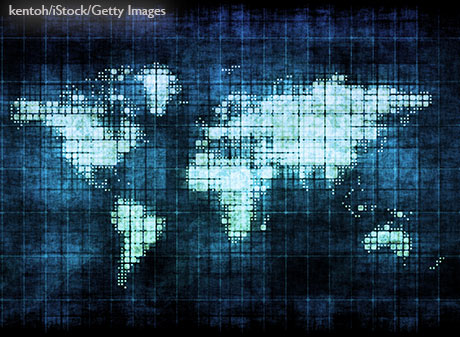How Does the COVID-19 Crisis Differ from Other Shocks to the Economy?

We are in unprecedented times, as attempts to reduce the spread of the coronavirus have led to a partial shutdown of the U.S. economy. The effects of stay-at-home orders and social distancing policies in response to the COVID-19 pandemic are showing up in economic data.
But the U.S. and global economies have been affected by crises before, and local economies have been hit by natural disasters like hurricanes.
How do these times compare? Economist David Wheelock, whose focuses include U.S. monetary policy and economic history, discussed similarities and differences in a recent Twitter Q&A. Wheelock is a group vice president and deputy director of Research.
While a similarity is that we’re seeing declines in economic activity, the current crisis is different from other shocks to the economy in many respects—including the causes and the public policy response, he explained.
Wheelock’s responses to three questions on crises historically are below. Questions and responses have been lightly edited for clarity and length.
Q: How is the current economic downturn different from the Great Recession and the Great Depression?
Wheelock: We are certainly in a very unusual economic downturn. We’re experiencing large declines in economic activity. However, the origins and the sources of this decline in economic activity are very different from the Great Depression of the 1930s or the recession of 2008-09.
Those earlier events were basically caused by financial imbalances and the policy response. In the 1930s, a series of banking panics resulted in a sharp decline in liquidity. The Federal Reserve unfortunately exacerbated the situation by not providing liquidity to stem those banking panics. The Great Recession of 2008-09 was preceded by a financial crisis that was caused by imbalances in the financial system associated with financing of subprime mortgages. Although the financial crisis was severe, the aggressive response by the Federal Reserve and federal government kept the recession that followed mild in comparison with the Great Depression.
The sharp decline in economic activity that we’re experiencing now is a response to the pandemic. The pandemic has necessitated an investment in public health, which entails asking the public to refrain from sitting in restaurants, taking unnecessary trips or doing more than the bare essential activities. This social distancing is really tuning down the pace of economic activity in the United States—and hopefully building a bridge to a day when the pandemic is under control and we have more effective treatments and, ultimately, a vaccine.
So, this situation is very different. Its causes are very different and the public policy response is very different. It’s only similar in the sense that we will see declines in the economic data, but it’s very different in many other respects.
Q: If the U.S. unemployment rate reaches 20% in the current situation, how would that compare to levels seen during the Great Depression?
Wheelock: In the Great Depression, we saw an unemployment rate of 25% of the labor force in 1933. Indeed, for the entire decade of the 1930s, the unemployment rate was at or above 10%—really unprecedented levels of unemployment.
We will undoubtedly see a very high unemployment rate for April, and perhaps continuing into May and beyond. Economists are estimating that we could see an unemployment rate of anywhere from 10% to as much as 30%. However, it is unlikely to be sustained for nearly the length of time that we had the high unemployment rate during the 1930s.
Another consideration when comparing the current situation with the 1930s is that in those days, there was no unemployment insurance. There was very little assistance at all coming from the federal government. There was no national food security program like SNAP (the Supplemental Nutrition Assistance Program). There was no Medicare or Medicaid or those sorts of programs. The social safety net was much smaller back in the 1930s. It was really just getting going in the middle of the Depression.
We are in some sense more fortunate today. I think that the unemployment rate will be high, but hopefully not sustained for nearly as long as it was back then. And we have more of a social safety net. Of course, that’s not to minimize the disruption and the suffering that many people who have lost their jobs or who are on furlough will feel in the current crisis. I wouldn’t want to minimize that at all. But at the same time, I’m hopeful that we won’t experience prolonged high levels of unemployment like we did during the 1930s.
Q: In terms of economic impact, how does the COVID-19 pandemic compare with natural disasters?
Wheelock: There are some interesting parallels between the COVID-19 crisis and a hurricane or a major snowstorm, for example. They come on very suddenly. They shut us down pretty rapidly. And hopefully, when the storm has passed, we can get more or less back to normal.
But there are some differences. With a hurricane, you get hit for a couple of days. It maybe does some damage, but then the sun comes out and you begin your cleanup. We’re hoping that the sun will come out one day with the COVID-19 crisis and that we can get things back to normal. We will have some economic damage to recover from. Some businesses will have to restart, and people will get back to their normal lives.
However, health policy experts tell us that we might have flare-ups of the virus and possibly a second wave later in the fall. And so we may not be able to relax the economic restrictions that have been put in place to deal with the virus as quickly as we would hope, or as quickly as we would with a hurricane. We’re hopeful for a rapid recovery in terms of the economy, but we have to be prepared for the possibility that there will be some bumps in the road as we recover.
There may be some long-term changes in behavior as well. With a hurricane, we might have new building codes put in place to try to minimize the damage from future hurricanes. We may also see behavioral changes and changes in regulation associated with the recovery from COVID-19. People might start wearing masks in the United States as a matter of course as they do in Asia, for example. Or we may see changes in how health care is delivered in the United States.
There are interesting parallels with other sorts of natural disasters, but we’re still in the early days here in terms of COVID-19. We’ll have to see how it plays out down the road.
Additional Resources
This blog explains everyday economics and the Fed, while also spotlighting St. Louis Fed people and programs. Views expressed are not necessarily those of the St. Louis Fed or Federal Reserve System.
Email Us



